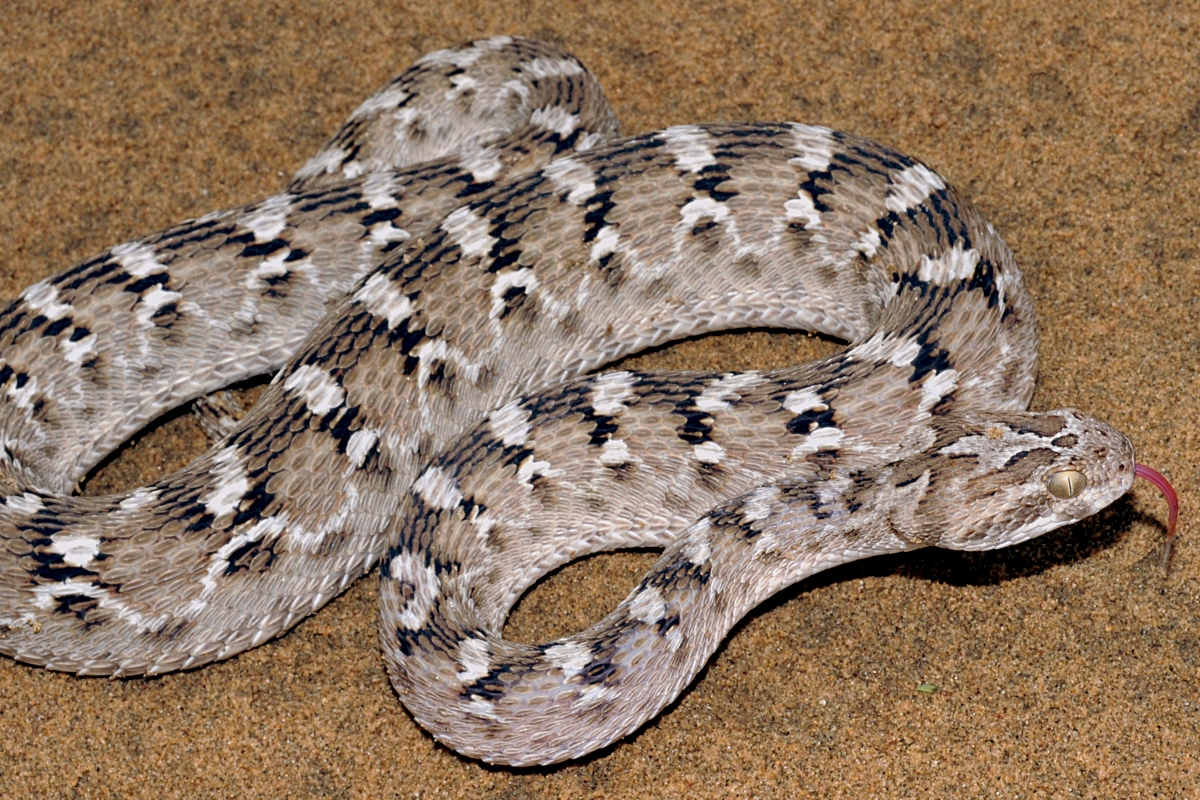Echis carinatus is a venomous viper species found in parts of the Middle East and Central Asia, and especially the Indian subcontinent.
It is the smallest member of the big four snakes that are responsible for causing the most snakebite cases and deaths, due to various factors including their frequent occurrence in highly populated regions, and their inconspicuous nature. Five subspecies are currently recognized, including the nominate subspecies described here.
Description
The size of E. carinatus ranges between 38 and 80 cm (15 and 31 in) in total length (body + tail), but usually no more than 60 cm (24 in).
Head distinct from neck, snout very short and rounded. The nostril between three shields, and head covered with small keeled scales, among which an enlarged supraocular is sometimes present. There are 9-14 interocular scales across the top of the head and 14-21 circumorbital scales. 1-3 rows of scales separate the eye from the supralabials. There are 10-12 supralabials, the fourth usually largest, and 10-13 sublabials.
Scalation
Midbody there are 25-39 rows of dorsal scales that are keeled scales with apical pits; on the flanks, these have serrated keels. There are 143-189 ventral scales that are rounded and cover the full width of the belly. The subcaudals are undivided and number 21-52, and the anal scale is single.
The color-pattern consists of a pale buff, grayish, reddish, olive or pale brown ground color, overlaid middorsally with a series of variably colored, but mostly whitish spots, edged with dark brown, and separated by lighter interblotch patches. A series of white bows run dorsolaterally. The top of the head has a whitish cruciform or trident pattern and there is a faint stripe running from the eye to the angle of the jaw. The belly is whitish to pinkish, uniform in color or with brown dots that are either faint or distinct.
Geographic range
E. carinatus is endemic to Asia. On the Indian subcontinent it is found in India, Sri Lanka, Bangladesh, and Pakistan (including Urak near Quetta and Astola Island off the coast of Makran). In the Middle East it is found in Oman, Masirah (Island), eastern United Arab Emirates, Iraq, and southwestern Iran. In Central Asia it is found in Afghanistan, Uzbekistan, Turkmenistan, and Tadzikhistan.
Habitat
E. carinatus is found on a range of different substrates, including sand, rock, soft soil and in scrublands. Often found hiding under loose rocks. Specimens have also been found in Balochistan at altitudes of up to 1982 m.
Behaviour
E. carinatus is mostly crepuscular and nocturnal, although there have been reports of activity during daylight hours. During the daytime they hide in all kinds of places, such as deep mammal burrows, rock fissures and fallen rotted logs. In sandy environments, they may bury themselves leaving only the head exposed. Often, they are most active after rains or on humid nights. This species is often found climbing in bushes and shrubs, sometimes as much as 2 m above the ground. When it rains, up to 80% of the adult population will climb into bushes and trees. Once, it was observed how some 20 individuals had massed on top of a single cactus or small shrub.
Feeding
E. carinatus feeds on rodents, lizards, frogs, and a variety of arthropods, such as scorpions, centipedes and large insects. Diet may be varied according to availability of prey. High populations in some areas may be due to this generalist diet.
Reproduction
The population of E. carinatus in India is ovoviviparous. In northern India, mating takes place in the winter with live young being born from April through August. Occasionally, births have also been recorded in other months. A litter usually consists of 3 to 15 young that are 115–152 mm in length.


